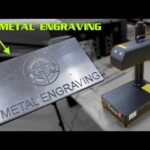
Laser Marking Machines have revolutionized the way we permanently mark materials, offering precision, speed, and versatility across a wide range of industries. From intricate designs on jewelry to essential serial numbers on industrial components, these machines use the power of light to create lasting impressions. This article explores the inner workings, applications, and benefits of laser marking technology.
Laser Marking Machines
| Feature | Description | Benefits | Applications |
| Process | Uses a focused laser beam to alter the surface of a material. | Non-contact, precise, permanent, versatile. | Marking, engraving, branding, serialization. |
| Laser Types | CO2, Fiber, UV | Each type suited for different materials and applications. | CO2: Wood, acrylic, leather. Fiber: Metals, plastics. UV: Sensitive materials, high-resolution marks. |
| Marking Mechanisms | Vaporization, color change, surface modification | Creates different visual effects. | Vaporization: Deep engravings. Color Change: High-contrast marks. Surface Modification: Subtle markings. |
| Materials | Wide range, including metals, plastics, wood, glass, leather, ceramics, textiles | Adaptable to diverse industries. | Manufacturing, electronics, medical, jewelry, promotional products, automotive. |
| Advantages | Precision, speed, permanence, non-contact, versatility, automation | Superior to traditional marking methods. | High-quality, efficient, durable markings. |
| Industries Served | Manufacturing, electronics, medical devices, jewelry, promotional products, automotive, aerospace, and more. | Wide applicability across sectors. | Part marking, product identification, branding, customization. |
| Key Applications | Part marking, serial numbers, barcodes, QR codes, logos, engravings, personalization, medical device sterilization marking. | Essential for traceability, branding, and customization. | Manufacturing, logistics, retail, healthcare. |
| Future Trends | Increased speed, improved precision, expanded material compatibility, integration with automation. | Continuous improvement and innovation. | More efficient and versatile marking solutions. |
How Laser Marking Works: A Symphony of Light and Material
At its core, laser marking involves using a focused beam of light to alter the surface of a material. Unlike traditional methods like engraving or printing, laser marking doesn’t involve physical contact, making it ideal for delicate or easily damaged items. The process begins with a laser source, which generates a concentrated beam of light. This beam is then directed through a series of mirrors and lenses, precisely controlled by a computer. The focused laser beam interacts with the material’s surface in one of several ways:

- Vaporization: The intense heat of the laser vaporizes a thin layer of the material, creating a depression or mark. This is commonly used for deep engravings and creating contrasting marks.
- Color Change: Some materials undergo a color change when exposed to the laser’s energy. This allows for high-contrast markings without removing any material. This is particularly useful for branding and creating visually appealing designs.
- Surface Modification: The laser can alter the surface properties of the material, such as its reflectivity or texture. This can create subtle but permanent markings, often used for security features or product identification.
Types of Laser Marking Machines: Tailored to the Task
Different laser marking machines utilize different laser sources, each with its own strengths and weaknesses:
- CO2 Laser Machines: These machines are cost-effective and versatile, ideal for marking non-metallic materials like wood, acrylic, glass, leather, and textiles. They are commonly used in the signage, packaging, and craft industries.
- Fiber Laser Machines: Fiber lasers offer high power and precision, making them perfect for marking metals, plastics, and ceramics. They are widely used in the automotive, electronics, and medical device industries for part marking, serialization, and branding.
- UV Laser Machines: UV lasers use a shorter wavelength, allowing them to mark a wider range of materials, including some plastics that are difficult to mark with other laser types. They are often used for marking sensitive materials and creating very fine, high-resolution marks.
Applications Across Industries: From Trinkets to Tools
The versatility of laser marking has led to its adoption in countless industries:
- Manufacturing: Part marking, serial numbers, barcodes, QR codes, and branding on components.
- Electronics: Marking circuit boards, microchips, and other electronic components.
- Medical Devices: Sterile marking of surgical instruments, implants, and medical equipment.
- Jewelry: Engraving intricate designs, personalized messages, and hallmarks on rings, necklaces, and other jewelry items.
- Promotional Products: Customizing gifts, awards, and promotional items with logos and messages.
- Automotive: Marking engine parts, chassis numbers, and other critical components for traceability and identification.
Benefits of Laser Marking: A Cut Above the Rest
Compared to traditional marking methods, laser marking offers several significant advantages:
- Precision: Laser marking can create extremely fine and detailed marks, allowing for complex designs and intricate patterns.
- Speed: Laser marking is a fast process, making it suitable for high-volume production.
- Permanence: Laser marks are highly durable and resistant to abrasion, chemicals, and extreme temperatures.
- Non-Contact: Laser marking doesn’t involve physical contact, minimizing the risk of damage to delicate materials.
- Versatility: Laser marking can be used on a wide range of materials, from metals and plastics to wood and glass.
- Automation: Laser marking machines can be easily integrated into automated production lines.
The Future of Laser Marking: Innovations on the Horizon
The field of laser marking is constantly evolving, with ongoing research and development focused on improving speed, precision, and material compatibility.
We can expect to see even more innovative applications of laser marking technology in the years to come, as it continues to push the boundaries of what’s possible. From personalized products to critical industrial components, laser marking machines are transforming the way we create and identify the objects around us. Sources and related content:



